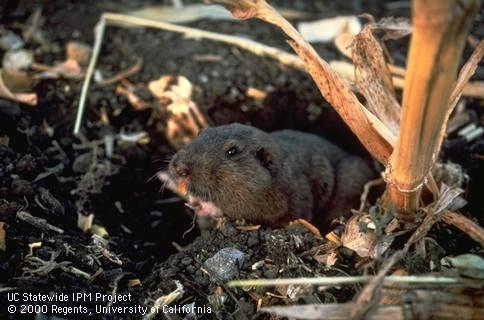In this blog article we answer some frequently asked questions about moles, voles, and gophers and their management.
How can I tell if I have moles, voles, gophers, or something else?
Moles: look for circular or volcano-shaped mounds with the plug in the middle, or a plug may not be apparent. The soil of mole mounds tends to be clumpier than gophers. Moles sometimes leave a raised ridge just beneath the soil surface while hunting for food.
Voles: look for aboveground runways that connect burrow openings. Grass usually covers the burrows. Voles can girdle trees aboveground while gophers girdle trees belowground.
Gophers: look for crescent or horse-shoe shaped mounds with a plug off to one side. Tunnels are 6-12 inches below ground.
Can gophers climb fences or into raised garden beds?
To some extent, yes. It is important to have an above-ground exclusionary device in place to keep them out of desired areas. Usually 12 inches of fencing is sufficient since they are not great climbers.

Should I use gopher baskets or underground fencing?
Gopher baskets can be used to protect individual plants. Underground fencing might be justified for valuable ornamental shrubs, landscape trees, or garden beds. Keep in mind metal wire will rust and disintegrate after several years to prevent plant roots from being strangled. Galvanized wire, and especially stainless-steel wire, will last much longer. Read more on gopher exclusion. For voles, wire fences or aluminum flashing around gardens can be effective. Learn more about vole exclusion. Installing a vertical underground barrier may provide temporary relief for moles. Read more about mole exclusion.
Should I treat the soil to remove insects or grubs to prevent moles, voles, and gophers from feeding?
Treating the soil with an insecticide would have no impact on gophers or voles because they feed on plant material, not insects. Doing so might reduce mole activity, but the effectiveness of this approach has not been proven.
What plants deter these pests?
Plants, including Euphorbia lathyrus, castor bean, Ricinus communis, and garlic have not proven through conducted research trials to be effective at protecting plantings from moles, voles, or gophers.
Are there any natural repellents that work?
Repellents containing castor oil have shown some repellency for moles in the eastern U.S., but their effectiveness against moles in CA is unknown. No other repellents have proven effective at protecting gardens or other plantings from moles, voles, or gophers. They are also not practical as you must apply them before damage occurs and some products may not be labeled for use on edible plants.
What traps are most effective?
The most effective trap is going to depend on which animal is present.
For gophers, 2-pronged pincer traps, such as the Macabee, Cinch, or Gophinator, can be used. Another popular type is the choker-style trap, such as the Gopherhawk. Learn more about gopher traps. For voles, a standard mouse trap can be effective. Learn how to place traps correctly. Harpoon, scissor-jaw, and pincer-style traps can be used for moles. Learn more about trapping moles.
Can I flood their burrow to kill them?
Flooding mole and vole burrows is ineffective at controlling them. For gophers, flooding can force them out of their burrows but you must kill them when they exit the burrow, otherwise they will return once it dries out. Since their burrows can be extensive and deep, flooding is usually just a waste of water.
What fumigants can I use?
Burrow fumigants with smoke or gas are not effective for moles, voles, or gophers.
The general public cannot use aluminum phosphide. This is a restricted use pesticide and often cannot be used in residential areas. You must have a pesticide applicator license to use it.
Pressurized exhaust machines and carbon dioxide injection devices are expensive and only practical for large infestations.
Are poison baits dangerous for nontarget wildlife and predators? How can they be used safely?
Toxic baits can harm nontarget wildlife, but since baits are placed inside burrows and the pest usually dies inside the burrow, predators and other wildlife are less likely to encounter the toxic bait and poisoned animals. Certain baits, known as first-generation anticoagulants (e.g., warfarin and chlorophacinone) generally require consumption over the course of several days to be effective–making them a potentially safer option. Always be sure to read the product label and make sure it will work against your specific pest, and be sure to understand the potential risks when using these toxicants. Note that not all products are legal for all 3 pests.
Will predatory birds, dogs, or cats control them?
Many predators including coyotes, foxes, badgers, weasels, cats, gulls, and especially hawks and owls eat voles and gophers. However, in most cases predators can't keep their populations below damaging levels. Installing barn owl boxes will likely not be enough to control these burrowing animals in urban settings either.
Do ultrasonic, sound-emitting, or vibrating devices work?
Electromagnetic or ultrasonic devices settings are ineffective against voles. Gophers and moles are not frightened by these devices.
How can you tell if a burrow or mound is active?
For moles and gophers, always look for the freshest activity as indicated by moist soil on the mound. The fresher the mound, the more likely the animal is still using the tunnel. For voles, look for fresh grass clippings and fecal pellets around burrow entrances and along runways.
How do I prevent moles, voles, and gophers from establishing?
Limit dense vegetation including weeds and heavy mulch that provide them protection. They are less common in non-vegetated areas.
How can you dispose of dead moles, voles, or gophers?
Bury them or place in a plastic bag in the trash. Never touch them with your bare hands as they can carry infectious pathogens and parasites.
To learn more about management of these pests, visit the Pest Notes fact sheets below:
Questions for this FAQ collected from the Moles, Voles, and Gophers webinar on May 16th, 2024.
Contributor - Cooperative Extension Specialist: Human-Wildlife Conflict Resolution